Pizza with Garlic Confit and Wilted Greens
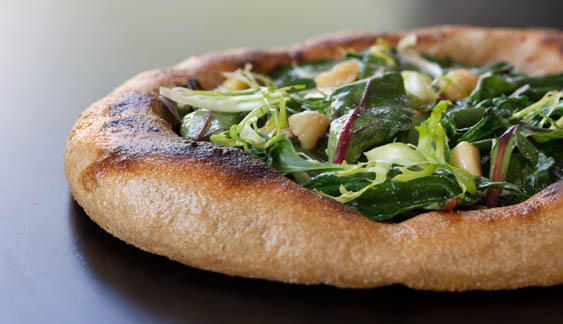
introduction
Inspired by a recipe from Tartine Bread, this light yet luscious pizza topping is an elegant way to showcase baby braising greens. Dressed lightly with cream and spiked with pepper flakes, the greens are piled high on a disc of dough and ride into an intensely hot oven. Moments later, the greens melt tenderly and the naturally leavened crust blisters and crisps. Mild, sweet garlic confit tucked between greens and crust sets the balance of ingredients off to perfection. No one will miss the pepperoni, that's for sure.
Baking Notes
Shaping and baking pizza can be tricky. Achieving a perfectly crisp bottom crust and light, bubbly edges requires practice. Have a look at our archived Instagram video that illustrates the stretching process. If sliding the pizza off the peel and onto the baking steel or stone gives you pause, here’s a foolproof alternative method: Instead of dusting the peel with semolina, line it with a 12-inch square of parchment paper before laying the shaped dough on top. When loading the pie into the oven, simply slide the pizza, parchment and all, onto the steel. The bottom crust of a pizza baked this way won’t be quite as crisp, but you’re guaranteed no sticking, no tearing, and no burnt bits on the baking steel.
Thanks to the slower-moving nature of levain, the dough rounds can stand at room temperature (70 to 74 degrees) for about 1½ hours without overproofing. This gives you enough time to shape, top, and bake three pizzas in succession. However, if your kitchen is warm, as you shape one dough round, keep others in the refrigerator until you’re ready to use them. This will guard against overproofing, which makes it more difficult to stretch and shape the dough because it is prone to tearing.
Note that the quantity of toppings in the ingredients list is for each pizza.
equipment mise en place
For this recipe, you will need a small saucepan; a wire skimmer or slotted spoon; an airtight container or jar; a pizza steel or stone; a bench knife; a pizza peel; a ruler; a large bowl; a wide metal spatula; a clean, dry kitchen towel; a wire rack; and a plate or rimmed baking sheet.
-
for the garlic confit:
-
2heads garlic
-
1½cups extra-virgin olive oil
-
-
for the crust:
-
Anson Mills Pizza Maker’s Flour, for dusting
-
Semolina mixture (provided with the pizza flour)
-
-
for topping each pizza:
-
2.5ounces (about 4 lightly packed cups) hardy baby greens, such as kale, spinach, chard, beet greens, mustard greens, or a mix thereof
-
1tablespoon heavy cream
-
Generous 1 teaspoon red pepper flakes
-
Fine sea salt
-
About 1 tablespoon garlic confit
-
-
Make the garlic confit: Remove the papery skins from each head of garlic and separate the heads into cloves. Peel the cloves and trim off the woody ends. If the cloves contain a germ (green sprout), cut each one in half lengthwise and pry out the germ from each half. Place the garlic cloves in a small saucepan and pour in the olive oil; the cloves should be fully covered. Set the pan over low heat, bring the oil to a very gentle, lightly bubbling simmer, and cook, stirring occasionally, until the garlic is very soft and tender, about 30 minutes. Remove from the heat and let to cool to room temperature.
-
Using a wire skimmer or slotted spoon, transfer the cooled garlic cloves to a small bowl. Pour the oil into an airtight container or jar and refrigerate for up to 2 weeks; it can be used to introduce subtle garlic flavor to a multitude of dishes or to make a second batch of garlic confit. Use a fork to mash the garlic cloves to a paste, drizzling in a little of the reserved oil as needed for a creamier, smoother texture. (Stored in an airtight container in the refrigerator, garlic confit will keep for up to 1 week.)
-
At least 1 hour before baking, adjust the oven rack to the upper-middle position and a baking steel or stone on the rack. Heat the oven as high as it will go, 500 or 550 degrees, and allow the steel to heat for at least 1 hour.
-
Shape the crust: Lightly dust your work surface with flour. Dust the top of one dough round, still in its proofing box, with flour. Slide a bench knife under the floured round, flip it out onto the prepared work surface, and dust again with flour (fig 9.1). Re-cover the other dough rounds to prevent drying. Sprinkle a pizza peel with a thin but thorough coating of the semolina mixture. Turn the oven to broil to crank up the heat on the surface of the pizza steel.
-
Create a moat around the circumference of the dough about 1 inch in from the edge by pressing with your fingertips (fig. 5.1). Gently degas the center of the dough with your fingertips and knuckles, leaving the border puffy; this will ensure a lofty outer edge of the baked crust. Pick up the dough round and, supporting the center of the round with an opened hand, gently toss it back and forth between your opened hands, allowing gravity and the tossing motion to gradually stretch the dough. Once the dough reaches a diameter of 6 to 8 inches, place it back on the work surface. Slide your hands underneath and, using the backs of your hands, gradually turn and stretch the dough to a 10-inch diameter (fig 5.2). Holding the dough over on the prepared pizza peel, slide your hands out from underneath to set the dough on the peel. Ideally the outer edge will not have deflated and the center will be of an even thinness. Give the peel a little wiggle to make sure the dough slides easily. If it grabs, toss more semolina under the area where it is sticking.
-
Top and bake: In a large bowl, toss the greens with the heavy cream until completely coated, then season with the pepper flakes and salt. Smear about 1 tablespoon of the garlic confit on the dough, avoiding the edge; it doesn’t need to cover the entire surface, just enough so that in each slice you get some garlicky essence. Pile the greens in the center of the dough (fig. 6.1) but don’t allow any pieces to fall on the edge as they may inhibit crust spring.
-
Return the oven to its highest baking temperature. Open the oven door and swiftly slide the pizza onto the baking steel. Close the oven door and bake for 1½ minutes. With a wide metal spatula, quickly rotate the pizza 180 degrees, then continue baking for 1½ minutes longer. Now turn on the broiler and bake until the edges are charred and blistered, 1 to 1½ minutes longer. Using the peel, transfer the pizza to a wire rack and let cool for a couple of minutes before cutting into pieces and serving.
-
Carefully wipe the surface of the baking steel with a dry kitchen towel, catching the semolina on a plate or rimmed baking sheet. Turn on the broiler and heat the steel for 10 minutes. Meanwhile, shape and top another dough round, then bake it the same way you did the previous one. Repeat the process a final time to bake a third pizza, if desired.
-
-
4.1
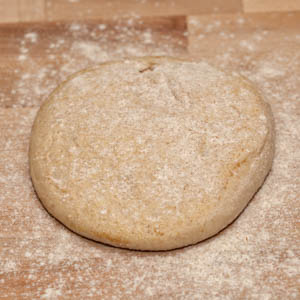
-
-
-
5.1
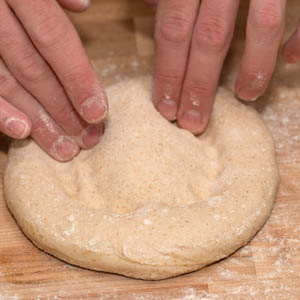
-
5.2
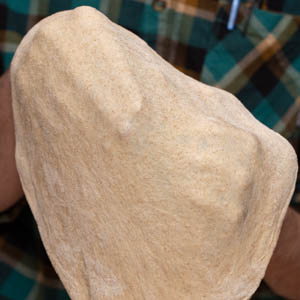
-
-
-
6.1
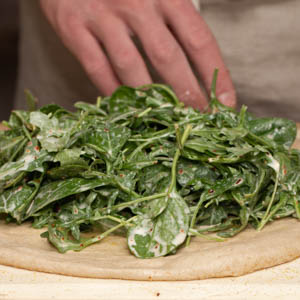
-
recipe developed by Henry Jones